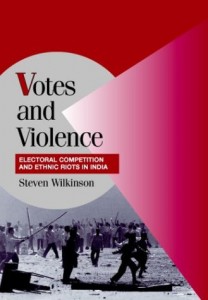Much of my work has been on the causes of ethnic violence, especially in South Asia. In my first book Votes and Violence: Electoral Competition and Ethnic Riots in India (Cambridge 2004) I explore the ways in which electoral incentives have increased or decreased the likelihood of communal riots in different towns and states and at different times in India.
In contrast to those who focus mainly on the supply side of violence, I focus more on the constraints. This is because “In virtually all the empirical cases I have examined, whether violence is bloody or ends quickly depends not on the local factors that caused violence to break out but primarily on the will and capacity of the government that controls the forces of law and order.” (p.5)
So what determines this government response?
My main argument is that “democratic states protect minorities when it is in their governments’ electoral interest to do so. Specifically, politicians in government will increase the supply of protection wheneither of two conditions applies: when minorities are an important part of their party’s current support base, or the support base of one of their coalition partners in a coalition government; or when the overall electoral system in a state is so competitive-in terms of the effective number of parties-that there is therefore a high probability that the governing party will have to negotiate or form coalitions with minority-supported parties in the future, despite its own preferences.” (p.7)
The book was pretty far along in the pre-publication process when the 2002 Gujarat riots broke out, and I delayed the book so I could spend some time analyzing how the model I put forward seemed to explain the pattern of violence in 2002. The answer I discovered was that it seemed to explain much of the variation: states with substantial minority representation in government and/or high levels of party competition, such as Bihar, Maharashtra, Andhra Pradesh and Rajasthan seemed to do much better in controlling the communal riots that erupted in 2002 than those states such as Gujarat where there was low party competition or minority representation in government was minimal.
Votes and Violence was joint winner of the American Political Science Association’s Woodrow Wilson Foundation prize in 2005 for the best book on government, politics, or international affairs published in the previous year.
Since Votes and Violence I have written several other papers on ethnic violence. Some have followed up the Indian story, exploring how well the model has done in accounting for patterns of violence and peace since 2004, or responding to specific criticisms that have been made of the argument. I have also written several more historically oriented articles and papers, looking at how an electoral incentives model might be adapted to look at historical cases before elections were introduced, or be applied to authoritarian governments.

